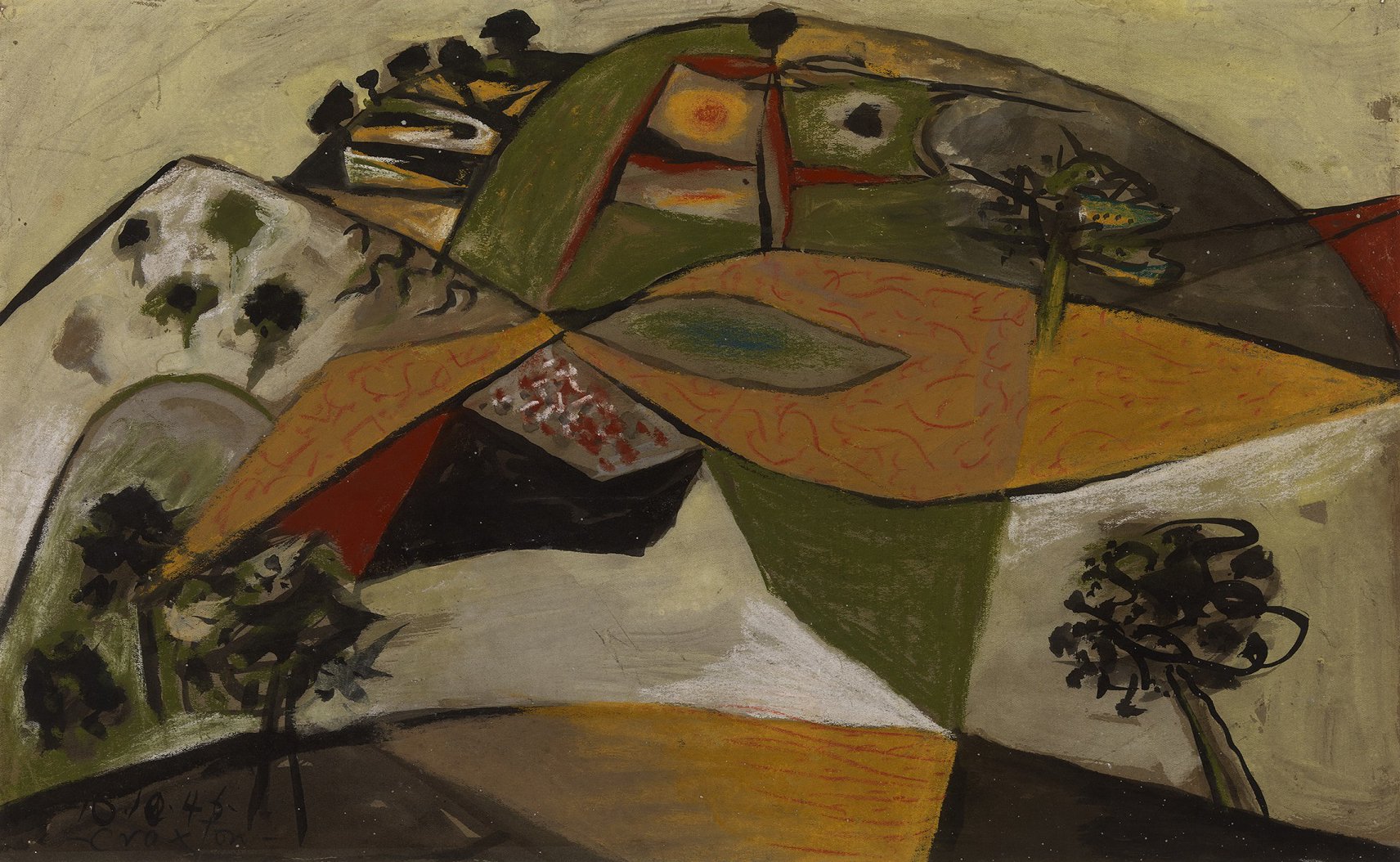A delicious country | John Craxton at Osborne Samuel
Landscape (Spetses, Greece), 1946, Mixed media & oil on paper, 30.3 x 48 cm. Signed and dated "10.10.46" lower left in ink. Courtesy of Osborne Samuel Gallery‘I can’t tell you how delicious this country is,’ wrote a 23-year-old John Craxton to his friend Elsie ‘EQ’ Nicholson, from Athens, on May 20, 1946. ‘…the lovely hot sun all day & at night tavernas: hot prawns in olive oil & great wine & the soft sweet smell of Greek pine trees. I shall never come home. How can I?’
He was meant to be in Switzerland, where he was showing a solo exhibition in a prestigious Zurich gallery, but a chance meeting at the vernissage changed all that. Lady Norton was the wife of the British ambassador to Greece, and she had a bomber aircraft waiting for her at an airfield in Milan, which she had requisitioned to pick up some Italian curtains to take back to the embassy in Athens. Did he want to come with her? Craxton loved adventure, and had been cooped up in London throughout the war. Of course he did.
He was almost true to his epistolary promise to his friend Elsie: he fell so in love with the country that he lived there, much more on than off, for the rest of his life. It wasn’t just the sun and the wine and the prawns and the pine: Craxton’s homosexuality was far less frowned upon in Greece than in England, and he had plenty of opportunities to satisfy his prodigious appetite for young men, particularly sailors in tavernas. He found he could be himself there.
The country suited his art, too. Craxton – deemed unfit for military service on health grounds – had spent the war studying at Goldsmiths College, living with his soulmate Lucian Freud. If anything, he was more successful in his early career than Freud, enjoying solo shows at the Swiss Cottage Café and the Leicester Galleries in 1944, adopting a Cubism-influenced style developed after an impactful pre-war viewing of Picasso’s Guernica. All the sun-drenched blues and greens and whites of Greece were a stark contrast to the muted hues of war-torn London. And so, as well as finding exciting new subject matter to paint, his palette erupted.
He had met the Greek artist Niko Ghika in London, and soon set up a tightly knit friendship group with Ghika, his old friend Joan Eyres and Joan’s husband, the writer and war hero Patrick ‘Paddy’ Leigh Fermor. And he found himself a new home: the island of Poros, where he lodged with an eccentric family and learnt to speak a demotic – and highly idiosyncratic – form of Greek. In early September Lucien Freud invited himself to stay – what could have stopped him? – and in early October the two friends went on a week-long painting holiday together in Spetses, in the Saronic Gulf. As a 24th birthday present Freud taught Craxton how to swim, and they both made sketches for future paintings.
Back in Poros, Craxton went to work on Landscape (Spetses, Greece) 1946, completing it on October 10. This joyful painting bears witness to the young painter’s love for his newly adopted homeland: a Cubist representation of the island where he had just spent what we can only imagine was a blissful week.
Freud’s career, of course, subsequently went stellar while Craxton’s gradually faded. Their relationship soured after Freud’s intimate (if platonic) feelings for Caxton cooled after meeting Francis Bacon, with whom he shared a similarly intense friendship. Craxton – who eventually made his Greek home in Crete - never stopped painting, exhibiting and developing his style, however, and has enjoyed something of a resurgence in popularity in recent years. This will surely be consolidated after the retrospective of his work at Pallant House this autumn. Which, one would hope, will attempt to answer this question: did Craxton fade from popular acclaim because he was exiled in Greece, far from the centre of the art market? Was it because his subject matter didn’t suit that market? Or was it just because he loved his flamboyant life in his beloved Greece even more than he loved painting?
You can currently see Landscape, (Spetses, Greece), 1946, at Osborne Samuel, as part of their summer exhibition.

